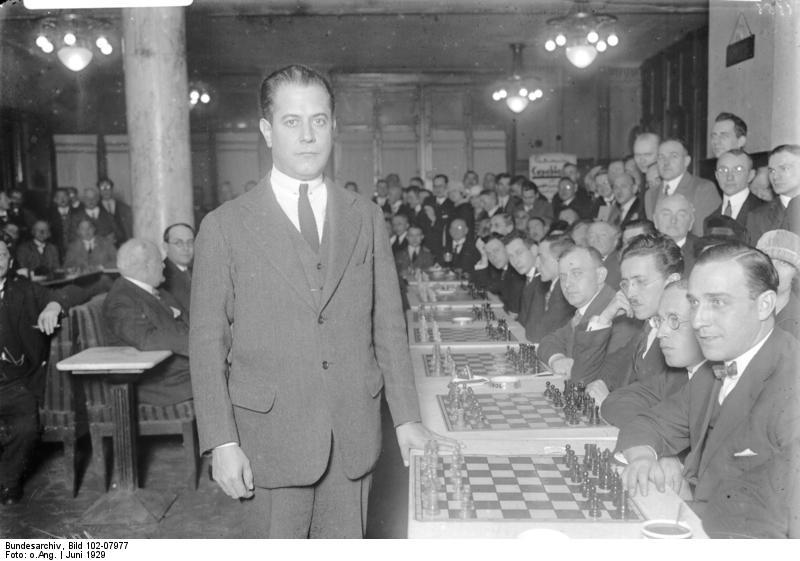
Clash of Champions: Capablanca vs. Lasker
After taking the title from Wilhelm Steinitz in 1894, Emanuel Lasker won a rematch against Steinitz in 1897. His reign as world champion lasted until 1921, and the 27 years he spent on the throne were the longest anyone has remained world champion.
I doubt that record will ever be broken.
However, Lasker did not defend his title very frequently or against the strongest challengers. In particular, he never faced Akiba Rubenstein, which would have been a great match. Partially this was the fault of World War I, but Lasker's unwillingness -- and demands of a high prize fund -- played a role.
During his reign he won some very one-sided matches against Marshall, Janowski, and Tarrasch. He also drew a match with Carl Schlecter, thereby retaining his title. In 1921, he faced his toughest challenge yet: the Cuban player Jose Raul Capablanca.

Capablanca was born in Havana, Cuba in 1888. He supposedly learned the rules of chess at four years old, and was a child prodigy who won a match against the Cuban champion, Juan Corzo, at the age of only 13.
Later, he began to play top international tournaments, and soon was Lasker's challenger for the world championship. Capablanca is remembered for his precise, clear, and simple style of play, like a Mozart of chess.
The match between Lasker and Capablanca took place in 1921. There had been negotiations for a match between the two players for a long time, but first some disagreements arose. Lasker then signed an agreement to play against Rubinstein until World War I prevented that match.
In fact, Lasker "resigned" the title in 1920, but neither the world nor Capablanca himself could accept such a conferring of the title. Thus a match took place in 1921, but Lasker insisted on being called the challenger. The match was held in Capablanca's hometown of Havana.

José Raúl Capablanca by Aris Gionis | CC
Here we will see the tenth game, considered by many to be the best of the match. Up until this point, it had been a tough and rather even fight. Capablanca was up only one game, having won the fifth game due to Lasker's blunder; the rest of the preceding games had been drawn.
But Capablanca's smooth win in the tenth round began Lasker's downfall. Capablanca won another two games soon after, and Lasker resigned the match after the 14th game, down 4-0.
The Queen's Gambit Declined produced a normal position with an isolated queen pawn. Slowly Capablanca gained the upper hand when Lasker's play was insufficiently active. After the queens were traded, Capablanca had all the advantages: a more solid pawn structure and more active pieces. But obtaining the active rook position -- behind the white b-pawn -- was crucial for Capablanca's success. Now he carried out a nice maneuver to achieve it.
Finally, one of the weaknesses in White's position fell. Now we will see how Capablanca efficiently wrapped up the game.
With this game, Capablanca took a two-point lead in the match, which was to be played to eight wins (or to 24 games total, if neither player reached that). Capablanca also won the very next game. Two draws followed, and then another Capablanca victory when Lasker made a simple blunder.
Lasker then resigned the match and Capablanca became the third world champion. In fact, coming back from such a deficit would be difficult. Since he was technically the challenger (thus a 12-12 tie after 24 games would lose the match for him) he would need to win five out of the next eight games -- very difficult against the solid Capablanca.
It has been said that Lasker was destined to lose this match, being much older than his opponent, shaken by the war, and also not used to the hot weather of Havana. Having held the world championship title for 27 years, Lasker had become ambivalent towards it, and even planned to resign the title had he won the match with Capablanca. Nevertheless, this was in fact quite a competitive match until near the end, as Lasker was still playing well.
RELATED STUDY MATERIAL
- Read the previous article in this series, Lasker vs. Steinitz
- Watch GM Dejan Bojkov's incredible greatest chess minds video series on Capablanca
- Play as Capablanca in his 1929 Barcelona tournament with the Chess Mentor
- Practice your world-championship-level combinations in the Tactics Trainer
- Looking for articles with deeper analysis? Try our magazine: The Master's Bulletin

